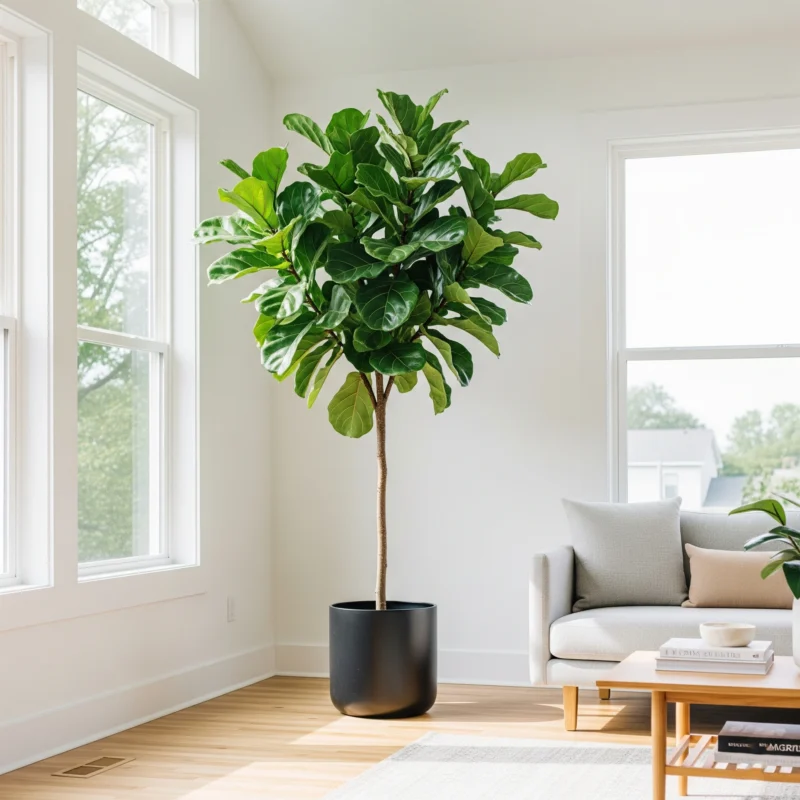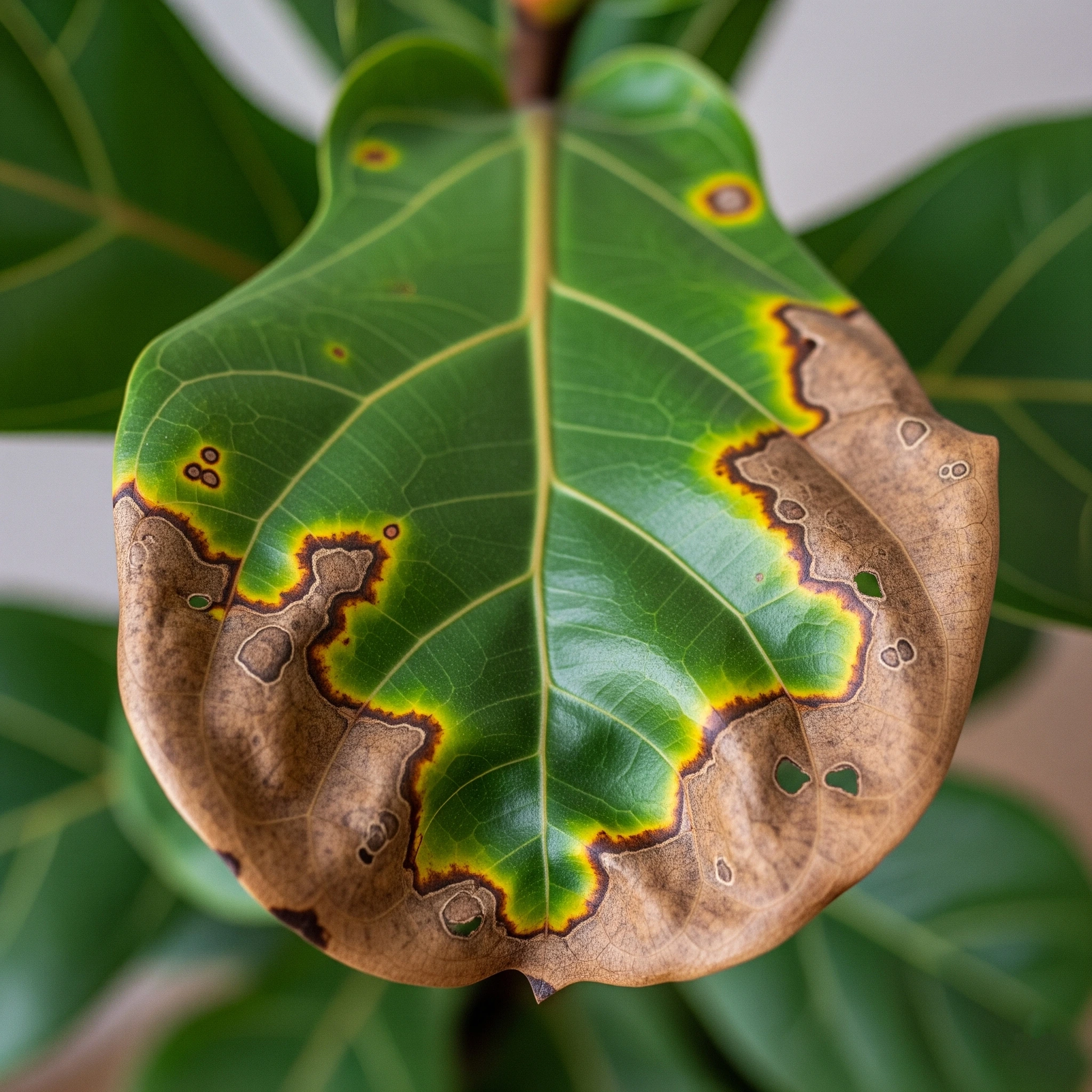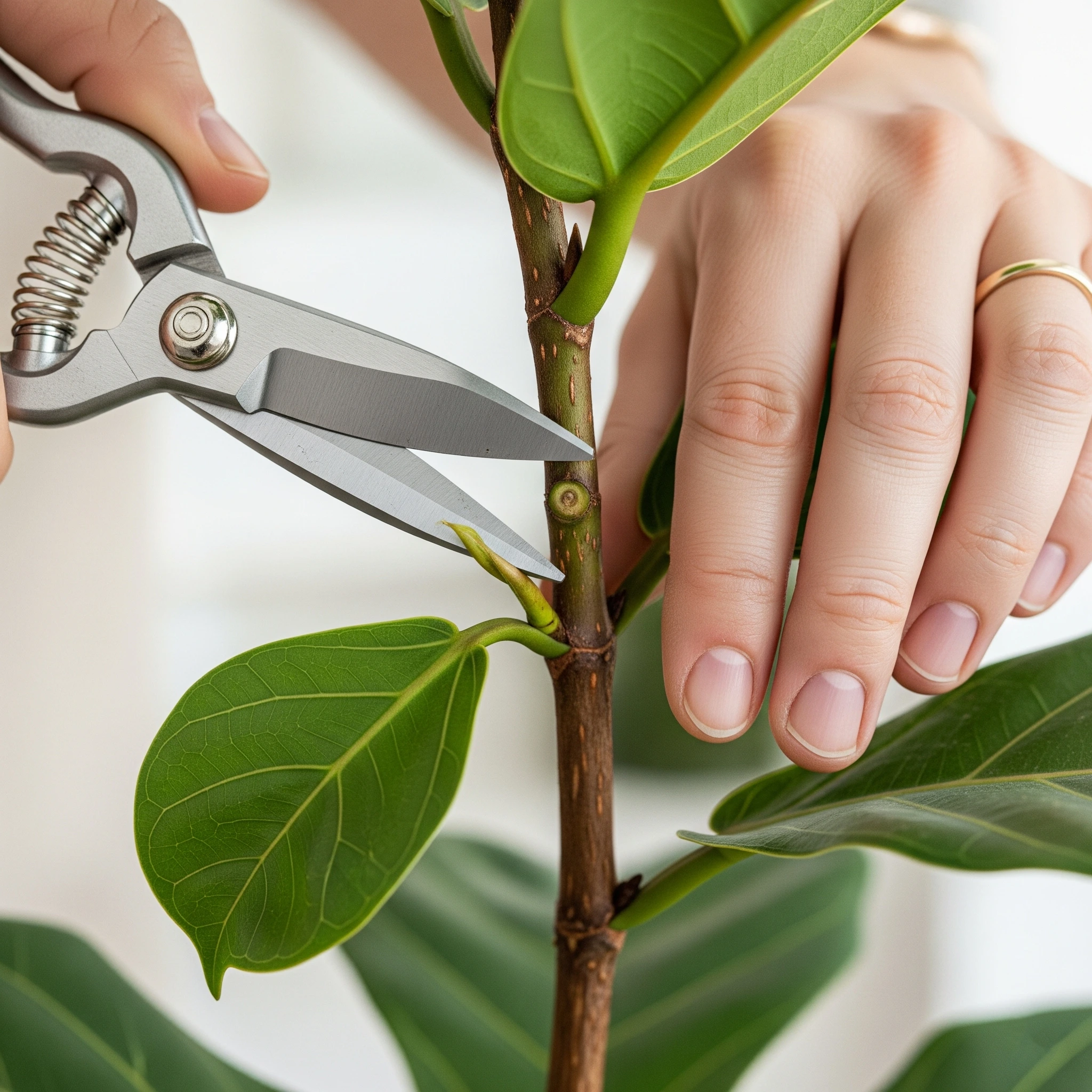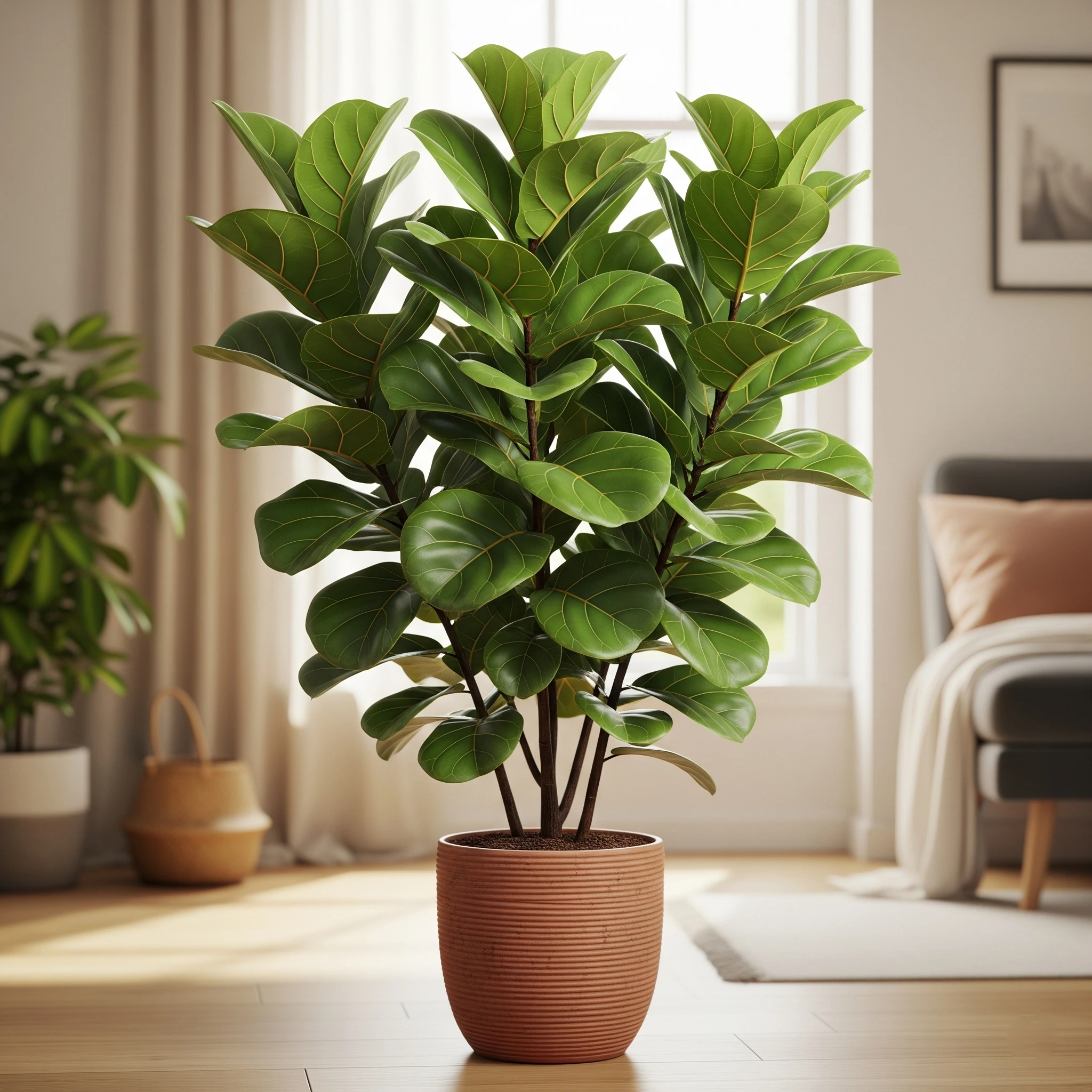The Fiddle Leaf Fig Care Guide: From Beginner to Expert (Australia & Canada)
Hello, brave plant parents in Australia and Canada! There are few plants as beautiful or as notoriously finicky as the Fiddle Leaf Fig (Ficus lyrata). With its giant, violin-shaped leaves and statuesque presence, it’s a dream plant for home decor. But for many, it’s a source of frustration, with dropped leaves and brown spots appearing seemingly out of nowhere.
Welcome to the ultimate Fiddle Leaf Fig care guide! This isn’t just a basic overview; it’s a comprehensive resource designed to arm you with the expert knowledge to not only keep your plant alive but to help it thrive. Whether you’re a beginner or a seasoned gardener looking to tackle this challenge, we’ll cover everything you need to know, from mastering the basics to troubleshooting common problems and even how to save a dying plant. Let’s turn your Fiddle Leaf Fig dreams into a lush reality!
The Fiddle Leaf Fig’s reputation as a difficult plant is well-earned, but not because it’s overly complicated. It’s because it’s a plant of strong, specific preferences. It dislikes change, needs consistency, and will tell you exactly what it thinks with a sudden drop of a leaf or a brown spot. This guide on how to care for a Fiddle Leaf Fig is designed to help you understand its personality so you can be a better plant parent.
- Why it’s so popular: Its large, sculptural leaves and tree-like form make it a stunning design element.
- The challenge: Its sensitivity to change in light, water, and temperature.
- The reward: A healthy, thriving Fiddle Leaf Fig is a testament to your care and a beautiful anchor for any room.
Personal Note: My Fiddle Leaf Fig once dropped half its leaves after I moved it just a few feet from its original spot in my Brisbane home! I learned the hard way that consistency is key with this notorious plant.
Mastering The Basics: Essential Fiddle Leaf Fig Care
The key to successful Fiddle Leaf Fig care lies in mastering these foundational needs and being consistent.
1. Light: The Non-Negotiable
- How much light does a Fiddle Leaf Fig need? This is the most crucial factor! Fiddle Leaf Figs need a lot of bright, indirect sunlight. They can tolerate a small amount of direct morning sun, but avoid harsh afternoon sun which will scorch their leaves.
- Where to place it: A bright room near a large east-facing or west-facing window is ideal. Rotating the plant every week or two will ensure even growth.
- Signs of a problem: Brown spots can indicate too much sun, while a lack of growth or small leaves can mean too little light.
2. Watering: The Biggest Challenge
- How often to water a Fiddle Leaf Fig? This is the number one question in Fiddle Leaf Fig care. The golden rule is to water thoroughly and deeply, but only when the top 2-3 inches (5-8cm) of soil are completely dry. Use the “finger test” to check.
- The “How”: Pour water slowly until it drains out of the bottom of the pot. Let all excess water drain away completely before returning the plant to its spot.
- Signs of a problem: Overwatering leads to root rot and brown or yellow spots on the lower leaves. Underwatering leads to brown, crispy edges on the leaves.
3. Soil & Potting: The Right Foundation
- What is the right soil for a Fiddle Leaf Fig? They need a well-draining soil mix. A mix of equal parts potting soil, perlite, and a small amount of orchid bark is a great recipe.
- How to repot a Fiddle Leaf Fig? Repot only when your plant is root-bound (roots are circling the bottom of the pot). Choose a pot that is only 1-2 inches larger than the current one. The best time to repot is in the spring or summer.
Pro Tip: *When repotting, be careful not to damage the root ball. This is a sensitive plant and root shock can cause leaf drop. (Source: Royal Horticultural Society – Repotting)
4. Fertilizing & Feeding
- How to fertilize a Fiddle Leaf Fig? They need to be fed regularly during the growing season (spring and summer). Use a balanced, liquid fertilizer diluted to half-strength.
- How often? Fertilize every two weeks during the growing season. Reduce to once a month in the fall and stop completely in the winter.
5. Humidity & Temperature
- What are the ideal conditions? Fiddle Leaf Figs are tropical plants and love high humidity and stable temperatures (18-24°C).
- The solution: Group your plants together, use a pebble tray, or a humidifier. Avoid cold drafts, sudden temperature changes, and placing the plant near air conditioning or heating vents.

Troubleshooting a Fiddle Leaf Fig: From a Pro (How to save a dying plant)
This is the section you’ve been waiting for. The truth is, these famous plants are very communicative. Here’s how to decode their signals and understand the true meaning behind common problems.
Why are my Fiddle Leaf Fig’s leaves turning brown?
- The problem: Fiddle Leaf Fig brown spots are a classic sign of either overwatering (brown spots all over the leaf) or underwatering (brown, crispy edges). It’s also a sign of inconsistent watering.
- The solution: Check the soil! If it’s soggy, you’ve overwatered. If it’s bone dry, you’ve underwatered. Let the soil dry out more between waterings to prevent this.
Why is my Fiddle Leaf Fig dropping leaves?
- The problem: Leaf drop is the Fiddle Leaf Fig’s way of protesting! It’s a sign of stress from a sudden change in environment (light, temperature, location) or a watering issue.
- The solution: If you’ve recently moved your plant, give it time to acclimate. Don’t move it around often. Once you find a good spot, let it be. Be consistent with your watering routine.
Why are my Fiddle Leaf Fig’s leaves turning yellow?
- The problem: Yellow leaves, especially on the lower part of the plant, are almost always a sign of overwatering.
- The solution: Let the soil dry out completely and check for root rot. If the roots are dark and mushy, you may need to repot into a fresh, well-draining soil mix and prune off the rotted roots.
How to save a dying Fiddle Leaf Fig
- The problem: If your plant is showing multiple signs of distress, it needs immediate action.
- The solution: Stop all watering. Move the plant to a brighter spot (indirect light). Inspect the roots for rot. Give it a gentle shake to encourage air circulation around the roots. Prune any completely dead or mushy roots and repot into fresh, well-draining soil. Patience is key! (Source: The Spruce – Fiddle Leaf Fig Problems)

Advanced Care: Pruning, Shaping & Propagation
Once you’ve conquered the basics, you can move on to helping your Fiddle Leaf Fig grow into a stunning specimen.
- Pruning & Shaping: Pruning helps create a fuller, bushier plant. Use sharp, clean shears to make a cut just above a node. This encourages new growth and helps maintain the plant’s shape.
- Propagation: You can propagate a Fiddle Leaf Fig from a stem cutting. Use a clean, sharp knife to cut a stem with at least one or two healthy leaves. Dip the cut end in a rooting hormone and place it in water or a well-draining soil mix.
- Staking: As your Fiddle Leaf Fig grows taller, a sturdy stake can provide support for the trunk, ensuring it grows straight and strong.

Fiddle Leaf Fig Care Q&A: Your Top Questions Answered
Where to place a Fiddle Leaf Fig in a room?
Place your Fiddle Leaf Fig in the brightest spot possible with indirect light. A few feet away from an east-facing or west-facing window is ideal. Avoid putting it in a spot where it gets direct, harsh afternoon sun.
How often should I fertilize my Fiddle Leaf Fig?
You should fertilize your Fiddle Leaf Fig every two weeks during its growing season (spring and summer) with a liquid fertilizer diluted to half-strength. Do not fertilize in fall or winter.
Do I need to mist my Fiddle Leaf Fig?
Fiddle Leaf Figs appreciate high humidity. If you have crispy brown tips, increasing humidity with a humidifier or a pebble tray is more effective than misting, which provides only a temporary boost.
What is the best pot for a Fiddle Leaf Fig?
A pot with drainage holes is non-negotiable for **Fiddle Leaf Fig care**. A terra cotta pot or a pot made of a porous material works well, as it allows the soil to breathe. Ensure the pot is only 1-2 inches larger than the current one.

Conclusion: Ready to Become a Fiddle Leaf Fig Whisperer?
The Fiddle Leaf Fig is a plant that demands attention, but in return, it offers an incredible reward. By mastering the basics and understanding its sensitive personality, you can confidently solve its common problems and nurture it into a stunning, thriving tree.
Embrace the challenge, be consistent, and watch your beautiful Fiddle Leaf Fig transform your home.
What is the one Fiddle Leaf Fig care tip you found most helpful in this guide? Share your thoughts and questions in the comments below!

